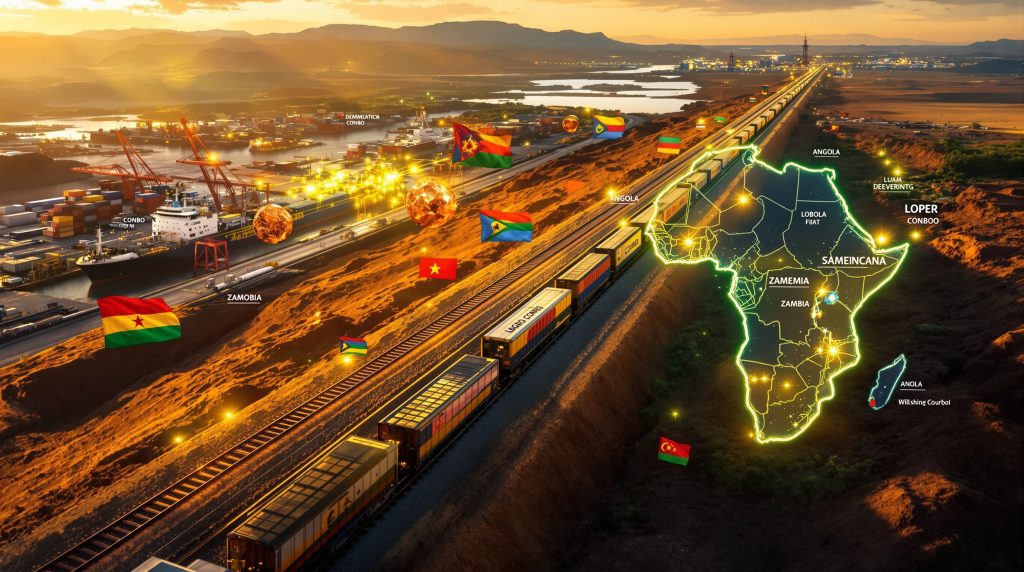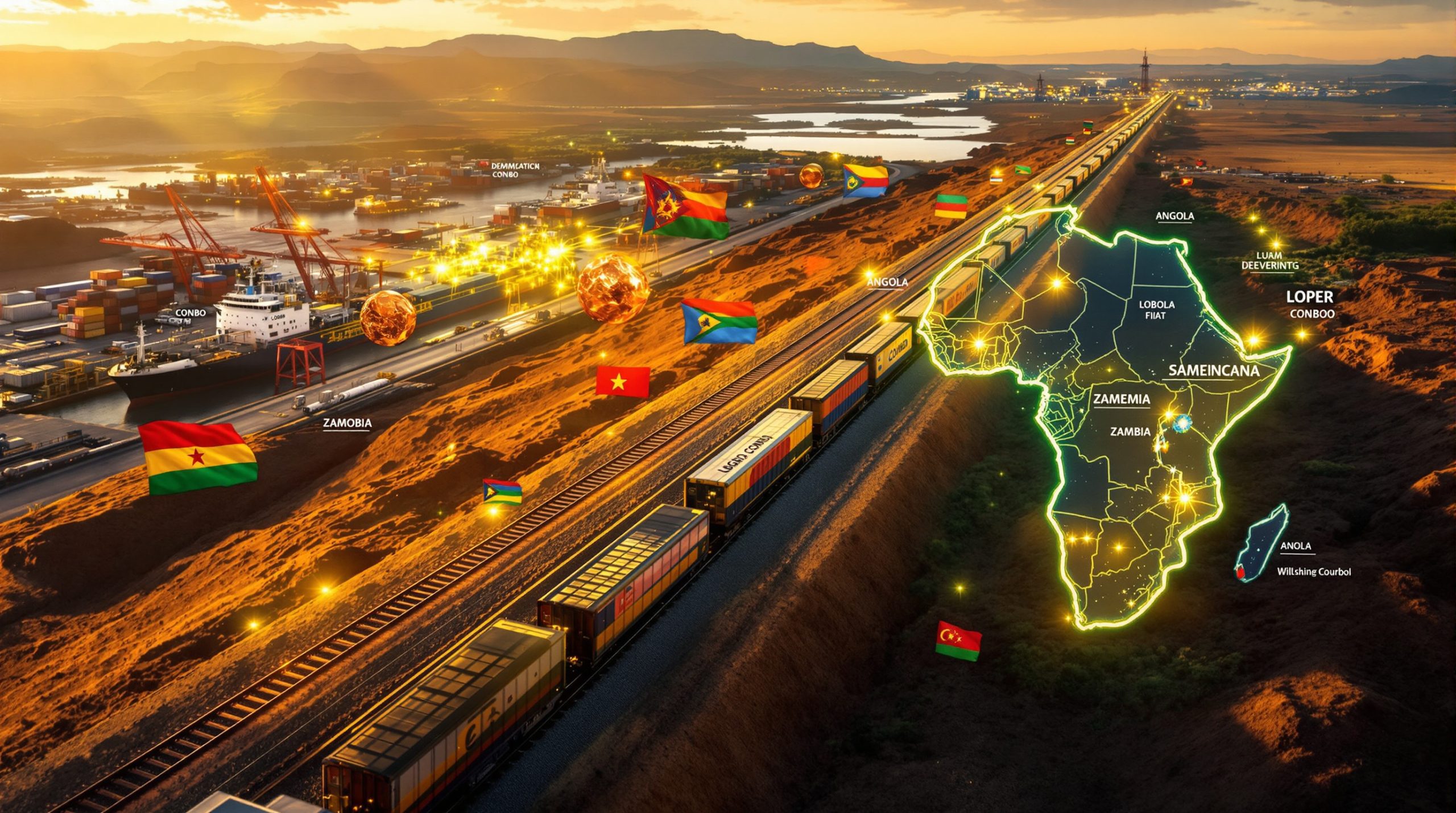The Strategic Importance of the Lobito Corridor
The Lobito Corridor stands as a transformative infrastructure project reshaping mineral transportation across Africa. This 1,300-kilometer transportation route connects Angola's Atlantic port of Lobito to copper and cobalt mines in the Democratic Republic of Congo (DRC) and Zambia. With approximately $10 billion in investment pledges from a diverse coalition including the United States, European Union, African Development Bank, and private sector consortia, the Lobito Corridor investment represents a significant commitment to securing critical mineral supply chains essential for the global energy transition.
What is the Lobito Corridor?
The Lobito Corridor primarily consists of the rehabilitated Benguela Railway, with planned extensions into Zambia. This infrastructure network creates a vital export channel for landlocked mineral producers, providing them with significantly improved access to global markets. The rehabilitation of this historic railway line represents one of the most substantial infrastructure investments in the region in recent decades.
The corridor's development demonstrates how strategic infrastructure can reshape regional economics, particularly for resource-rich nations that have historically struggled with export logistics. By dramatically reducing transit times and costs, the Lobito Corridor is positioning itself as the preferred export route for Central African minerals.
Why This Corridor Matters Geopolitically
The Lobito Corridor has become a focal point in global competition for influence over critical minerals transition. Western nations view the corridor as essential to diversifying supply chains away from Chinese dominance, particularly for minerals crucial to renewable energy technologies and electric vehicles.
This substantial financial commitment reflects growing recognition that control over transportation infrastructure translates directly to influence over mineral resources. With Africa holding approximately 30% of the world's known mineral endowment—potentially more, as the continent remains underexplored—securing reliable transportation routes has become a strategic imperative for major powers.
Major Infrastructure Investments Across Africa
The Lobito Corridor represents just one element in a broader pattern of infrastructure investment reshaping Africa's mineral logistics landscape. Multiple competing rail networks are currently in various stages of development, each offering distinct advantages for mineral exporters.
Competing Rail Networks in Development
Beyond the Lobito Corridor, several other major infrastructure projects are underway:
-
Trans-Kalahari Railway: This ambitious 1,500km project aims to connect Botswana's coal fields to ports, potentially transforming the export capabilities of this landlocked nation.
-
Tanzania-Zambia Railway Authority (TAZARA): A planned $1.4 billion upgrade by Chinese interests to improve the 1,860km railway linking Zambian mines to Tanzania's Dar es Salaam port. This represents a significant Chinese investment in securing access to Central African resources.
-
North-South Corridor: The traditional route from the DRC's Copperbelt through Zimbabwe to South Africa's Durban port has seen declining volumes over the past 15 years due to increased competition from other transportation options.
These parallel developments highlight the intense competition to establish dominant transportation corridors for Africa's mineral wealth, with each route backed by different geopolitical interests.
Comparative Advantages of Different Export Routes
Each corridor offers distinct benefits for mineral exporters, with factors including transit time, shipping flexibility, and geopolitical backing influencing exporters' choices:
| Corridor | Primary Advantage | Journey Time | Key Minerals |
|---|---|---|---|
| Lobito | Fastest transit time | ~8 days | Copper, cobalt |
| Durban | Containerized shipping flexibility | ~25 days | Copper, PGMs |
| TAZARA | Chinese investment backing | Variable | Copper, cobalt |
| Trans-Kalahari | Access to Botswana resources | In development | Coal, other minerals |
The Durban route, despite its longer transit time, continues to offer advantages for certain exporters. According to Andrew Shaw, chief strategy and planning officer at Transnet, "Durban offers an advantage for copper exporters in that containerized copper can be shipped in smaller quantities via scheduled vessels by different customers to destinations around the world." This flexibility remains valuable for producers with diverse customer bases.
How is the Lobito Corridor Already Transforming Mineral Logistics?
Despite being in relatively early stages of its full development, the Lobito Corridor has already demonstrated substantial practical benefits for major mining operations in the region.
Early Success Stories
The corridor's potential is already being realized through concrete operational improvements. Ivanhoe Mines now transports copper concentrate from its Kamoa-Kakula complex in the DRC to Lobito Port, dramatically improving logistics efficiency. This early adoption by a major mining company signals strong industry confidence in the corridor's viability.
This shift has reduced journey time from approximately 25 days (via road to Durban) to about 8 days by rail—a remarkable 68% reduction in transportation time. Such dramatic improvements in logistics efficiency translate directly to improved profitability and competitiveness for mineral producers in the region.
Operational Improvements and Efficiency Gains
The railway connection provides several significant advantages over traditional transportation methods:
-
Reduced transportation time by over 65%, improving cash flow and reducing working capital requirements
-
Lower carbon footprint compared to long-haul trucking, aligning with growing ESG requirements for mining companies
-
Improved reliability and reduced risk of delays, particularly during rainy seasons when road transportation becomes problematic
-
Enhanced safety for valuable mineral shipments, reducing theft and damage risks
These efficiency gains extend beyond simple cost savings. By dramatically reducing transit times, the corridor enables more responsive supply chain management and potentially opens new markets for Central African minerals that were previously constrained by logistics challenges.
International Investment and Geopolitical Competition
The development of the Lobito Corridor has become emblematic of the intensifying competition between global powers for influence over African resources and infrastructure.
US-EU Investment Strategy
The United States and European Union have made the Lobito Corridor a centerpiece of their strategy to secure critical mineral supply chains:
-
In 2023, they signed a memorandum of understanding with African finance agencies to support development
-
The corridor aligns with Western efforts to diversify supply chains away from Chinese dominance
-
This infrastructure investment represents a shift toward more strategic engagement with African resources rather than traditional aid-based approaches
The corridor's development has continued to receive support across changing political administrations in the United States, indicating its importance transcends partisan politics. The US‑China trade war has further intensified the strategic importance of securing reliable access to critical minerals, creating unusual policy continuity.
China's Competing Interests
China maintains significant influence in African infrastructure development:
-
Previous $2 billion investment in the Benguela Railway between 2006-2014 as part of a rail-for-oil program
-
Ongoing TAZARA railway upgrade project valued at $1.4 billion
-
Extensive mining interests throughout the DRC and Zambia that benefit from improved transportation options
While Western powers have taken the lead on the Lobito Corridor, China continues to pursue alternative transportation corridors across the continent. This multi-front approach to securing transportation infrastructure reflects China's long-term strategic vision for maintaining access to critical minerals.
Critical Minerals and Global Supply Chain Security
The Lobito Corridor provides access to some of the world's most strategically important mineral deposits, making it a focal point in global competition for resource security.
Strategic Resources Along the Corridor
The minerals accessible via the Lobito Corridor represent essential inputs for the clean energy transition and advanced technologies:
-
Copper: Essential for renewable energy infrastructure and electrical systems, with Central Africa hosting some of the world's highest-grade deposits
-
Cobalt: Critical for electric vehicle batteries and electronics, with the DRC controlling approximately 70% of global production
-
Tantalum: Used in advanced electronics and aerospace applications
-
Other critical minerals: Including resources necessary for clean energy technologies and high-tech manufacturing
The concentration of these resources in Central Africa makes the region's transportation infrastructure of strategic importance far beyond local economic considerations. Recent copper market trends have only increased the importance of reliable transportation infrastructure.
The Race for Resource Security
The corridor represents a focal point in the global competition for critical minerals:
-
The US-brokered "Critical Minerals for Security and Peace Deal" between the DRC and Rwanda in June 2025 represents efforts to stabilize the region for resource development
-
Increasing focus on securing supply chains independent of geopolitical rivals has intensified competition for transportation infrastructure
-
Growing recognition of Africa's 30% share of global mineral endowment has elevated the continent's strategic importance in global resource politics
According to Claude de Baissac, founder and CEO of Eunomix (a corporate risk advisory firm for Africa), the competition between major powers is playing out across resource-rich regions: "Africa, Latin America and parts of Asia are where the competition between major powers for critical minerals is playing out."
Will the Lobito Corridor Deliver Broader Economic Benefits?
While the corridor promises significant logistical improvements for mineral exporters, important questions remain about whether these benefits will extend beyond the extractive sector to support broader economic development.
Potential for Regional Development
The corridor presents several potential pathways for broader economic impact:
-
Development of processing facilities along the route to capture more value locally
-
Growth of supporting industries and services catering to increased rail traffic
-
Improved agricultural export options for communities along the corridor
-
Potential tourism development leveraging improved transportation infrastructure
However, realizing these broader benefits will require intentional policies and investments beyond the core infrastructure development itself. Without such measures, the corridor risks becoming merely an export channel for raw materials rather than a catalyst for broader economic transformation. Lessons from past experiences with mineral beneficiation in South Africa highlight the importance of deliberate policies to create local value addition.
Expert Perspectives on Development Outcomes
Some experts express skepticism about whether the corridor will deliver on broader development promises. Claude de Baissac of Eunomix has warned that international involvement appears "purely transactional" and focused through a "geopolitical lens."
De Baissac noted that superpower competition for African resources may not advance broader economic development: "The US is unlikely to be a force for positive change because it is motivated by self-interest, and there is a significant risk that US involvement will benefit only itself and a few corporates."
This perspective highlights the need for African governments to negotiate terms that ensure infrastructure developments serve national development goals rather than merely facilitating resource extraction. Without such arrangements, benefits may concentrate among international corporations and local elites rather than supporting inclusive growth.
Future Prospects and Challenges
The Lobito Corridor continues to evolve, with several initiatives underway to expand its capacity and enhance its regional connectivity.
Expanding Capacity and Connections
Key developments on the horizon include:
-
Ongoing port modernization at Lobito to increase handling capacity
-
Planned railway extension into Zambia to broaden the corridor's reach
-
Potential integration with other regional infrastructure networks to create a more comprehensive transportation system
-
Investments in digital monitoring and logistics optimization to improve operational efficiency
These expansions will determine whether the corridor can fulfill its promise of transforming regional transportation economics or remain limited in its impact. Furthermore, lessons from Namibian mining challenges could provide important insights for the corridor's development across multiple jurisdictions.
Sustainability and Long-Term Viability
For the Lobito Corridor investment to deliver lasting benefits, several challenges must be addressed, as highlighted by the OECD:
-
Maintaining infrastructure in challenging environments with limited institutional capacity
-
Ensuring security along the route, particularly in regions with ongoing political instability
-
Balancing mineral extraction with environmental protection to avoid creating new ecological problems
-
Creating meaningful economic opportunities for local communities to ensure broad-based support
Environmental sustainability represents a particular challenge, as increased mineral extraction could exacerbate ecological pressures in sensitive regions. According to the Atlantic Council's analysis, balancing economic development with environmental protection will require careful planning and robust regulatory frameworks.
FAQ: Lobito Corridor Investment
How does the Lobito Corridor compare to other African rail projects?
The Lobito Corridor is currently the most advanced major rail project in Southern Africa, with $10 billion in committed investment and operational sections already transporting minerals. Other projects like the Trans-Kalahari Railway and TAZARA upgrade remain in earlier development stages. The corridor's completion and early operational success give it a significant head start in attracting mineral traffic.
What minerals will primarily benefit from the Lobito Corridor?
Copper and cobalt from the DRC and Zambia are the primary commodities currently being transported via the corridor. These minerals are essential inputs for renewable energy infrastructure and electric vehicle batteries, making them strategically important in the global energy transition. The corridor could eventually transport other critical minerals including tantalum and various battery metals as regional mining operations expand.
How does geopolitical competition influence the corridor's development?
The corridor has become a focal point in competition for influence over critical mineral supply chains, with major powers making significant investments in regional infrastructure. This competition has accelerated investment but also raised concerns about whether geopolitical interests might override local development priorities. The tension between resource security objectives and inclusive development remains a central challenge for the corridor's long-term impact.
What environmental considerations impact the Lobito Corridor?
Environmental concerns include the carbon footprint of increased mining activity, potential habitat disruption along transportation routes, and water resource management challenges. While rail transportation offers lower emissions than road alternatives, the overall environmental impact depends on how mining operations themselves are managed and regulated. Sustainable development will require balancing economic benefits with environmental protection.
How can local communities maximize benefits from the corridor?
Communities along the corridor can potentially benefit through direct employment in transportation and logistics, development of supporting industries and services, improved market access for agricultural products, and infrastructure improvements. Realizing these benefits requires policy frameworks that incentivize local content, skills development programs, and investments in complementary infrastructure like rural feeder roads to connect communities to the main corridor.
Are You Positioned to Capitalise on the Next Major Mineral Discovery?
As Africa's mineral logistics landscape transforms through the Lobito Corridor and competing infrastructure projects, smart investors are gaining the edge on emerging opportunities. Visit Discovery Alert's dedicated discoveries page to understand how significant mineral discoveries can generate substantial returns, and start your 30-day free trial of their proprietary Discovery IQ model for instant notifications on ASX mineral discoveries.



